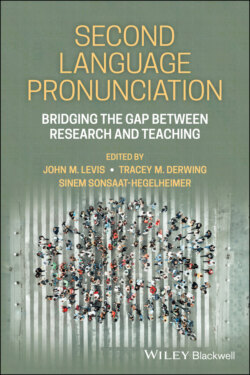Читать книгу Second Language Pronunciation - Группа авторов - Страница 40
Practical Resources for Pedagogy
ОглавлениеWhile many HVPT studies have examined this technique’s efficacy in the lab, their focus tends to be very narrow, investigating only a small number of sounds in a small number of phonetic or word contexts. As such, they do not comprise complete training systems which can be turned public-facing for consumption by a wide range of learners. Nor do they typically provide the opportunity for scalable research, since they are largely designed for one-off studies investigating a specific pronunciation issue faced by a particular group of learners. Even platforms that have been used to conduct research in the context of real language programs suffer from similar limitations (e.g., Thomson, 2011, 2012a; Wang & Munro, 2004.
A handful of HVPT researchers have attempted to make their platforms available to the public. Iverson and Evans’ (2009) British English Vowel Trainer was a mobile HVPT application, but it no longer seems to exist. Linguatorium Auris (LA) (Linguatorium Smart Language Systems, 2021), is an empirically validated HVPT system (Qian et al., 2018), bundled with a vocabulary training application. One of LA’s strengths is that it includes a variety of learning tasks beyond those normally associated with HVPT. This should encourage learner engagement. LA is also adaptive, targeting only those sounds that the system determines a particular user needs to target. A limitation of LA is that it only utilizes two training talkers, both of which are artificial. Thus, despite constituting HVPT in terms of its use of variable phonetic contexts, it only marginally qualifies as HVPT with respect to its number of talkers. English Accent Coach (EAC) (Thomson, 2018b) is largely a traditional listen-and-click version of HVPT training for vowels and consonants. It also includes a game called Echo (reminiscent of the 1980s Simon game, but with speech sounds instead of musical tones). EAC utilizes 30 talkers, producing North American English sounds in nearly every phonetic context. It also allows selection of sounds in either nonsense syllables or in real words. Unlike LA, EAC is not adaptive, requiring that users determine their own focus of instruction.
Both LA and EAC allow learners to create personal accounts to track their progress over time. LA is offered on a per semester basis, for a nominal fee, whereas EAC is currently free. Thomson (2012b) provides a detailed teacher-oriented description of EAC, along with some suggestions for activities to extend learning from the computer to the classroom. LA has less public documentation. Ultimately, both applications would benefit from built-in modules to encourage learners to practice the production of sounds that they are learning to perceive. This may facilitate faster transfer to production.
While it may be theoretically possible for instructors to build their own HVPT systems, if the goal is to include many talkers and sounds in many contexts, the recording process alone is a massive obstacle to overcome. Ideally, publicly available programs would provide the basic infrastructure and sound database, with the possibility of instructors adding targeted recordings of particular words as needed. With improvements in Text-to-Speech technology, it might be possible to create stimuli using a wider range of artificial voices, assuming that they all reflect the same target accent variety.
